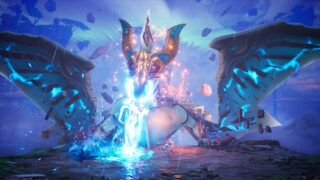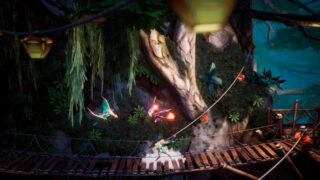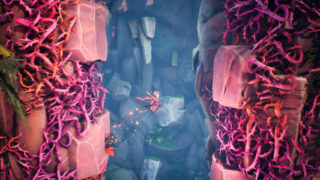Review: EA’s Tales of Kenzera: ZAU is a challenging, poignant Metroidvania
ZAU is a strong debut for Surgent Studios, but some stumbles stop it from being truly great
- Creative director
- Abubakar Salim
- Key Credits
- Zi Peters (Lead designer)

We are in the midst of a Metroidvania renaissance. Metroid: Dread, Ori, Hollow Knight, Dead Cells, and more have kept fans of the genre fully satiated in recent years. 2024 has already seen the launch of one of the genre’s best in Price of Persia: The Lost Crown.
The DNA of all of these games and more can be found in Tales of Kenzera: ZAU. This is the debut project from Surgent Studios, helmed by actor Abubakar Salim. Salim, a veteran of stage and screen, is a lifelong fan of games and with ZAU turns his hand to development.
An incredibly personal project, Tales of Kenzera: ZAU reflects on grief, inspired by the loss of Abubakar’s father, Ali. Ali was a software engineer and introduced Abubakar to gaming. Ali passed away in 2013, and it’s this grief that’s at the core of Tales of Kenzera: ZAU’s narrative.
The game tells the story of Zau, a young man who is attempting to revive his father, a task he and the player secretly knows is fruitless. Zau has to capture the souls of a series of titanic monsters to submit them as an offering to the God of the Dead.
Tales of Kenzera: ZAU’s story is largely told through dialogue married to comic-book-style renditions of the game’s characters. These comic book characters are the game’s strongest visuals, and we’d love to have seen fully animated cutscenes in this art style.
The game’s vocal performances are strong, and the characters never outstay their welcome, even if they’re largely unremarkable. Tales of Kenzera: ZAU is full of interesting lore about the game’s wider world, but this information is often given to the player as a reward for finding a secret in the world.
We’d have preferred some of this information to be slightly less obscured, but having lore as a reward rather than a new skill or skill point is an interesting change.
Tales of Kenzera is full of rock-solid platforming challenges. Striking a balance between tough and controller-breakingly annoying, Kenzera’s platforming evokes Guacamelee, Super Meat Boy, and the aforementioned Metroid Dread.
While your movement options are fairly limited, it’s used in many incredibly challenging ways. There are second-perfect jumps, extended platforming challenges, and some sections that will have your hands contoured in a vice-like grip around the controller.
“Striking a balance between tough and controller-breakingly annoying, Kenzera’s platforming evokes Guacamelee, Super Meat Boy, and the aforementioned Metroid Dread.”
The game’s combat is largely split between two different modes, each represented by a mask that imbues Zau with different powers. The Moon mask is more ranged, while the Sun mask is up close and personal. You can switch between the masks at will, which makes for fast-paced action, but the game’s combat isn’t massively deep.
Some combat areas in the game will lock you in the room until you’ve defeated all of the enemies, which can be frustrating. It’s a bit of a stumble following an interesting section of platforming to then be forced to do somewhat pedestrian combat.
The game’s Metroidvania elements similarly don’t feel fully explored. For Metroidvania, you really don’t spend too much time returning to previous areas to unlock secrets, an issue that grows at the game goes on. This element of the game feels most like something from a studio’s first game. There’s a lack of depth, and the feeling that the interesting mask concept could have been expanded further.

Visually, the game is a mix of highs and lows. The environments are vibrant and visually distinct but never encumber the platforming gameplay. Each of the game’s areas blends realism with fantasy in interesting ways, and it’s a hugely colourful world to explore. The mix of Afrofuturism and fantasy makes for a unique setting that is full of inventive visual setpieces.
The real downside, and the game’s biggest presentational weakness is the character models themselves. The humanoid 3D models feel dated and out of place in the environments, and they’re shown in an even worse light when compared to the cartoon renders of the characters.
It feels like there’s a filter missing, or a level of detail issue as we regularly had characters’ eyes notably bulging out of their heads, which was distracting when played against some of the game’s more poignant moments.
Tales of Kenzera: ZAU is a great start from a promising studio, even if it does feature some hallmarks of a studio’s first game. We’d be incredibly interested to try a follow-up from Surgent Studios once the lessons from their first foray into development have been learned and some of the rougher edges have been buffed.
The game just about stands confidently alongside other Metroidvanias, even if it doesn’t elevate above its inspirations. The game’s high points are its platforming challenge, its evocation of Bantu culture, and its central analogy of the game’s difficulty mirroring the difficulty of grief.
Tales of Kenzera: ZAU feels like a studio stretching its legs for the first time. Visually inventive, and full of great platforming, average combat and exploration lets it down.
- Afrofuturism aesthetic makes for a unique setting
- Challenging platforming
- Enjoyable soundtrack
- Average combat
- Limited exploration




















